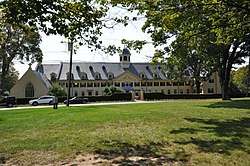Middlebury Center Historic District
The Middlebury Center Historic District encompasses the historic civic and religious center of Middlebury, Connecticut. Centered at the junction of North and South Streets with Whittemore Road, the district includes churches, schools and municipal buildings, many from the late 19th or early 20th centuries, as well as a diversity of residential architecture. The district was listed on the National Register of Historic Places in 1985.[1]
Middlebury Center Historic District | |
 The Westover School | |
  | |
| Location | Roughly bounded by Library Rd., North and South Sts., and Whittemore Rd., Middlebury, Connecticut |
|---|---|
| Coordinates | 41°31′35″N 73°7′33″W |
| Area | 103 acres (42 ha) |
| NRHP reference No. | 85001019[1] |
| Added to NRHP | May 9, 1985 |
Description and history
Middlebury was settled in the early 18th century, but did not begin achieving an independent identity until 1790, when a congregational parish was authorized. It was incorporated in 1807, its land taken from surrounding towns. The town remained an agricultural area, lacking waterpower for industrial development and transport, and bypassed by the railroads. The town center arose at a junction of multiple roadways, where the first Congregational church was built, and in its early years included services such as a blacksmith and tavern. Due to its quiet rural nature, there has been little residential development in the center since 1840, with many of its civic and religious buildings added later, some as replacements for earlier structures.[2]
The oldest surviving building in the district is an 18th-century house, now on the grounds of the Westover School, whose campus is a major feature of the center. The oldest church in the district is the Greek Revival Methodist Church, built in 1832, although the 1935 Congregational Church is a reproduction of an 1845 Greek Revival building lost to fire. The adjacent town hall, a brick neo-Federalist brick building, was also built in 1935, the previous one having succumbed in the same fire. The Catholic St. John of the Cross Church, built in 1902, is a fine example of Colonial Revival architecture.[2]
See also
| Wikimedia Commons has media related to Middlebury Center Historic District. |
References
- "National Register Information System". National Register of Historic Places. National Park Service. November 2, 2013.
- "NRHP nomination for Middlebury Center Historic District". National Park Service. Retrieved 2018-09-28.